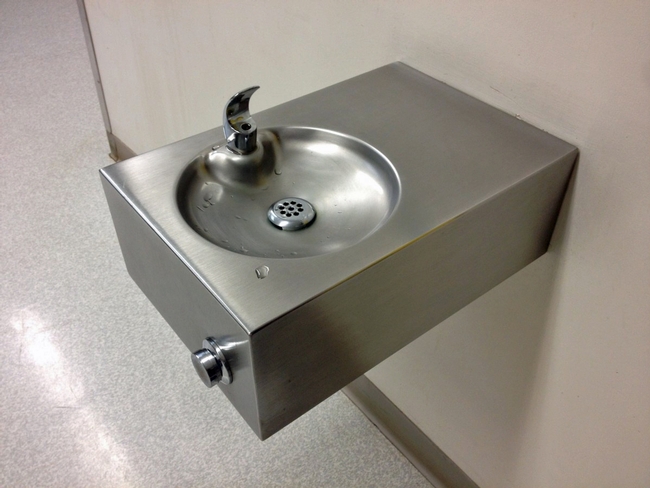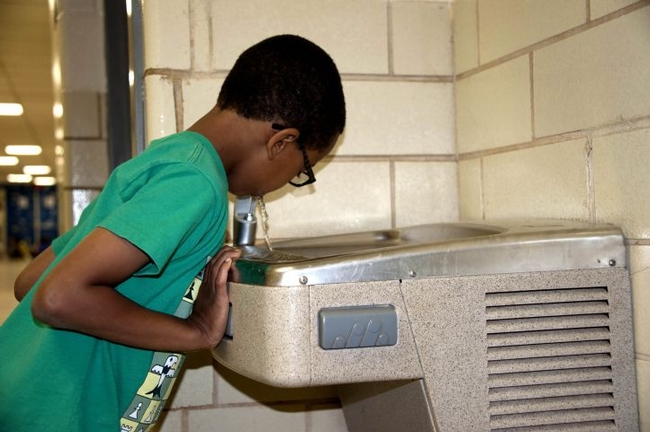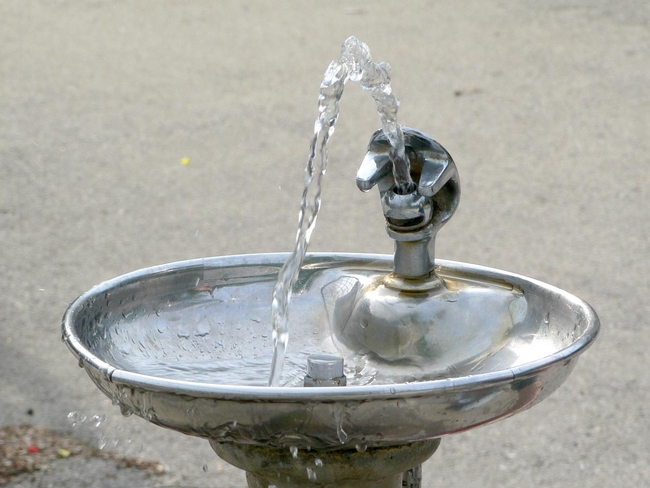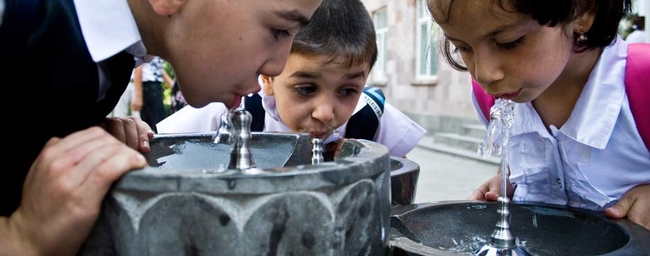Posts Tagged: drinking water
California schools test water for lead, 3% exceed state limit
The first study of California law that requires schools to test tap water for lead found that the majority completed the testing on time, and only 3% reported any tested taps with lead in the water higher than the state's 15 parts per billion (ppb) limit. About 30% of the 240 randomly selected public schools in the study didn't report their results within three months of the deadline.
The study, Water Safety in California Public Schools Following Implementation of School Drinking Water Policies, was published in the January issue of Preventing Chronic Disease, a Centers for Disease Control and Prevention online publication.
Christina Hecht of the UC Nutrition Policy Institute, one of the study's co-authors, said she was heartened by the results, and acknowledged there is more work to do.
“Because we strongly encourage people to drink water rather than sugary beverages, we need to have confidence that tap water is safe,” she said. “But this is a complex issue with shared responsibility among public water systems, school administrators and regulating agencies.”
Access to safe drinking water in schools is essential to help avoid the developmental and health consequences for children associated with consuming contaminated water, under hydration or excessive intake of sugary beverages.
Schools that get water from public utilities can expect the water they receive to meet federal and state water quality standards. However, 16% of study schools received water from a utility that violated health-based standards, such as elevated levels of contaminants or failure to adhere to disinfectant protocols. When water flows into buildings through pipes that contain lead – such as those made entirely of lead, or galvanized iron or leaded brass, or connected with lead solder – and especially when water sits stagnant in lead-containing plumbing, lead may leach into the water before it flows from the tap.
In October 2017, California passed Assembly Bill 746, which mandated that public water utilities sample and test for lead in tap water of public schools that were built before 2010. The law is designed to identify and mitigate sources of lead in water. Funds to upgrade school drinking-water plumbing were also earmarked in the state budget. Working with their local water suppliers, the schools selected taps for sampling. The number of taps that released water with lead was very low, and even those sources are not necessarily unhealthy for drinking, Hecht said.
“When we test tap water, we're not talking about every drop of water that comes from the tap,” she said. “We test the first water that comes out of the tap after it has been stagnant in the pipes. Once the taps are in use and water is flowing, the lead level should drop dramatically.”
Although few schools (3%) had even one tap in violation of California state standards for lead, violations increased to 16% when the federal Food and Drug Administration standard for bottled water was applied. The FDA requires that bottled water not exceed 5 ppb of lead.
The 174 schools in the study collectively tested 1,238 independent water sources – such as playground, hallway and gym drinking fountains, classroom faucets, food service areas and restroom taps in 2019. Some of the tests took place in locations that serve staff, such as teachers' lounges, nurses' stations, distribution sources and maintenance areas. Without detailed guidelines to follow, some schools tested only 1 tap; others tested as many as 76.
“Testing only a subset of taps in a facility prevents full identification of which schools need to undertake lead remediation actions,” Hecht said.
Hecht and her co-authors – Isioma Umunna, Anisha Patel and Lauren Blacker of Stanford University, Marc Edwards of Virginia Tech, and Emily Altman of UC Berkeley – conclude that, in the future, states should require schools to test to nondetectable levels of lead for maximum data collection and require that at least one water source in food service areas be tested.
The information and recommendations from the study are already informing California legislation designed to protect children from lead exposure from water. A new law, Assembly Bill 2370, will require all licensed childcare centers to test taps for lead by 2021 and every 5 years thereafter. The inconsistencies experienced in AB 746 compliance revealed the need for detailed guidelines on the number of taps facilities should test, the required locations for testing, clear naming conventions to identify taps and reporting procedures.
Study finds schools across the nation have too much lead in drinking water
Despite increasing awareness of the issue of lead in drinking water, UC Nutrition Policy Institute and Harvard School of Public Health researchers found that many students in the U.S. attend public schools in states where not all taps are tested for lead, according to reports in various media outlets including The Guardian, NBC News and The Nation.
“All kids, no matter where they live, should have access to safe drinking water in school,” said Angie Cradock of Harvard's Prevention Research Center on Nutrition and Physical Activity, who led the study team. “Drinking water is important for helping kids grow up healthy, and water should be safe to drink.”
The researchers found that there is no uniformity in states' approaches to create and oversee programs to test for elevated lead in school drinking water. When collected, data are not regularly made available to guide action to reduce potential exposure to lead. About half of the country's students are at public schools in states that don't have programs or requirements to test drinking water in those schools.
Of the 24 states (plus Washington, D.C.) with a statewide program to test school drinking water for lead, only 12 states had data that could be analyzed by the research team. In these 12 states, 44 percent of all schools had at least one tap that tested higher than their state's threshold for action, and 12 percent of all samples had a lead concentration higher than the state's action level. The report also describes the features of statewide initiatives in operation between Jan. 1, 2016, and Feb. 28, 2018, in 24 states and the District of Columbia to conduct testing for lead in school drinking water.
The report was funded by Healthy Eating Research, a national program of the Robert Wood Johnson Foundation.
For more information, see the Harvard T. H. Chan School of Public Health website.
Joining forces to promote child health and wellness
According to current statistics, approximately 40 percent of school-age children in the U.S. are overweight or obese. This statistic is reflected in rising rates of diabetes, pre-diabetes, and heart disease risk factors. Nearly one-quarter of all children are pre-diabetic or diabetic at the time when they leave high school, a figure that has increased dramatically in the last decade. Dental problems, the other very common health problem of youth, carry the potential for current and future pain, infection, and tooth loss. Although low-income children and children of color are at particular risk for both conditions, risk is unacceptably high for all children.
It is important to note that these all-too-common conditions share the same critical risk factor: consumption of sugary foods and beverages. Unknown to many, over half of the added sugar consumed by children is ingested in liquid form—soda, fruit drinks, sports drinks, energy drinks, and other pre-sweetened beverages including iced teas and others. For teenagers sugar-sweetened beverages are the single largest source of calories in their daily diet. Further, research has demonstrated that liquid sugar is more highly related to obesity than added sugar coming in solid form.
To improve the medical and dental health of our children we need to help children and families find ways to reduce their consumption of sugar-sweetened beverages.
Fortunately research is being conducted to find effective ways to reduce children's sweetened beverage consumption.
- Reduce provision of sweetened beverages in the school, after school and childcare settings. UC ANR's Nutrition Policy Institute (NPI) has documented dramatic reductions in sugary beverage consumption after the enactment of state restrictions on the sale of highly sugared beverages in California schools and childcare. While much has been accomplished, more can be done to see that these kinds of restrictions are fully maintained.
- Offering children easy access to water stations and other free tap water sources in childcare settings, schools and recreational facilities provides a healthful alternative to sugary beverages.
- Encourage strong nutrition education programs for children. UC Cooperative Extension's EFNEP and statewide SNAP-Ed programs have been leading efforts to educate children on the value of a healthy diet including the risk of consuming too many sugary beverages.
- Similarly, educating families on healthy eating and on the benefits of reducing sugar-sweetened beverage consumption can support and reinforce the messages to children in the school-based programs.
A consistent message on sugary beverages delivered to families by dental and medical health practitioners, in tandem with other educational and community efforts, can substantially benefit children's health. As respected community members, dental and medical health practitioners are in a position to deliver consistent messages to families and also to work with community agencies and groups, including UC ANR and its affiliates, to initiate and support efforts to reduce children's and families' sugary beverage consumption. Our children deserve a healthy start.
For more information, see:
- Nutrition Policy Institute (http://npi.ucanr.edu)
- National Drinking Water Alliance (http://www.drinkingwateralliance.org/about)
- Dooley D, Moultrie N, Sites E, Crawford P. Primary care interventions to reduce childhood obesity and sugar-sweetened beverage consumption: Food for thought for oral health professionals. Journal of Public Health Dentistry, 16 June 2017. DOI:10.1111/jphd.12229.
The UC Nutrition Policy Institute drives a drinking water movement
The alliance aims to make plain water the easy, appealing substitute for sugary beverages – soda, energy drinks, fruit drinks, and sweetened coffee and tea drinks. The alliance is also actively working on the safety of tap water in the nation's schools and childcare settings.
“To make water the beverage of choice will require a movement,” said Christina Hecht, a member of the NPI team. “NPI will build bridges, spearhead the creation of shared resources, align messages, strategies and aims, and coordinate strong external communications.”
NPI was formed by UC Agriculture and Natural Resources in 2014 to conduct, evaluate and share research related to the impact of nutrition and physical activity on public health. The W.K. Kellogg Foundation has awarded NPI a $960,000 grant to coordinate the National Drinking Water Alliance for three years.
“Even when water is available, too many children and adults choose sugar-sweetened beverages,” said Hecht, who will serve as the National Drinking Water Alliance coordinator. “In our American diet, sugary drinks are the top source of added sugars for both adults and children, and, remarkably, they are the single largest source of calories for teens aged 14 to 18.”
But Hecht is quick to point out that if people are to make the switch to water, water needs to be easily accessible and they need to know that it is safe to drink.
High consumption of sugar-sweetened drinks is associated with obesity and other chronic health problems, such as heart disease and diabetes. UCLA scientists reported in March that the diabetes epidemic in California is “out of control.” The study says 55 percent of the state's population has prediabetes or diabetes – many of them are undiagnosed.
“Simply switching to water is a relatively easy lifestyle change that can have a big impact on the intake of added sugar and excess calories, reducing diabetes risk,” Hecht said. “It can also improve oral health.”
The National Drinking Water Alliance includes government agencies, education officials, researchers, water industries, and non-governmental organizations like the Center for Science in the Public Interest, American Academy of Pediatrics Campaign for Dental Health, and the American Heart Association. They believe by sharing knowledge, resources and connections, they will hasten progress toward their common goal.
Fortunately, the current state of safe drinking water in the U.S. is mostly favorable. About 90 percent of Americans get their water from public utilities and 95 percent of those supply safe water. In some areas, however, water can become contaminated on the path between utility and tap, typically with lead. Sometimes other contaminants can leach in through breaks in pipes.
“We all recognize that, if we are going to tell people to drink water, they need to have confidence that the tap water is safe,” Hecht said. “At the moment, we don't know the magnitude of the problem of unsafe drinking water. The alliance is highly focused on policy as the most effective tool to bring about broad change.”
The National Drinking Water Alliance plans a Congressional hearing on national drinking water and is developing best practices for effective access to safe drinking water in schools and childcare settings.
Avoiding the water quality problems suffered in Flint
Congress and health groups are looking at a provision of a 2010 child nutrition law to get schools to test their water, and considering how to help schools pay for it.
The Politico reporter spoke to Christina Hecht, a senior policy adviser at the UC ANR Nutrition Policy Institute. The institute is the hub for the National Drinking Water Alliance, a network of organizations and individuals across the country working to ensure that American children can drink safe water in the places where they live, learn and play.
Hecht pointed out that the Healthy Hunger-Free Kids Act of 2010 requires schools to provide potable water during meal times. The act also says that child care facilities that participate in federal meals programs must give kids access to drinkable water throughout the day.
Because of this wording in the law, USDA could issue a guidance requiring schools to test their water to be sure it is potable.
"The beauty of this approach is that the language is there ... the means for oversight is there," Hecht said. "When you look at Flint, where does the buck stop? When you look at schools and child care, we've identified where the buck stops."
The cost to test water at schools nationwide is estimated to be about $7.6 million. For adult and child-care sites it would be about $14 million. In all, the expenditure works out to about 40 cents per child.
"We at the Nutrition Policy Institute encourage Congress to appropriate funds for tap water testing in American schools, and remediation where necessary," Hecht said.






